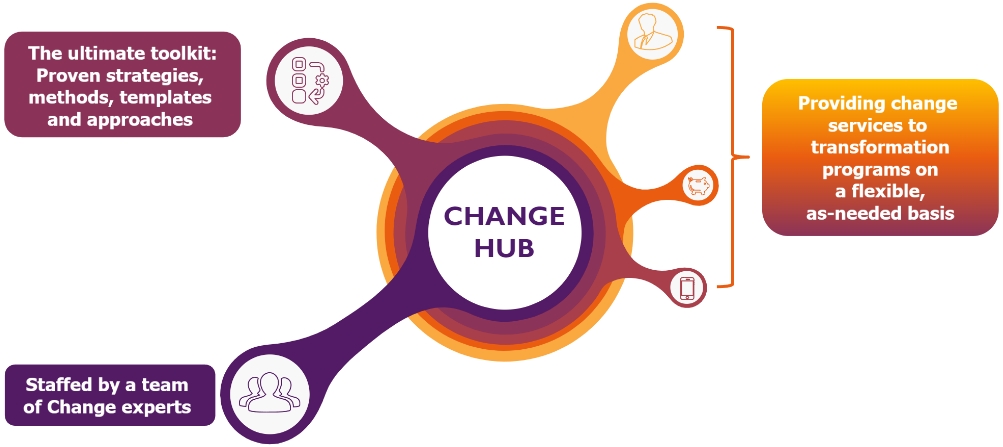A Change Hub revolutionizes the way enterprises manage change by tapping into external expertise and resources expressly designed to lead multiple, complex change efforts. Imagine having a dedicated support system that ensures smooth and transparent change management, reducing the risks associated with delivery. A Change Hub staffed with external experts can be brought in wherever and whenever business demand for change management is greatest, ensuring a flexible, consistent approach across all change programs.
The effectiveness of a Change Hub is rooted in four critical dimensions:
- A toolkit that ensures consistency: To ensure consistency across all programs, the Change Hub utilizes proven strategies, methods, templates, and approaches. This toolkit includes best-in-class leadership alignment practices, change impact assessments, optimized communications templates, persona development tools, user adoption metrics, culture change approaches, governance frameworks, and training models.
- Change experts that ensure quality: The Change Hub is staffed by motivated and energetic change experts with extensive change delivery experience and a passion for helping organizations elegantly manage complex transformations. They are deeply familiar with the change toolkit, can hit the ground running, and bring first-hand experience of both successful change programs and many of the challenges that can emerge along the change journey.
- A flexible approach that ensures cost-effectiveness: The Change Hub and its resources can quickly pivot to serve the areas where the need is the greatest. Most change programs go through busy periods and quiet periods, and the Change Hub immediately pivots resources to support the busiest, in-demand programs. As a result, organizations can manage change needs with fewer FTE resources.
- A rotation program that ensures employee development and engagement. The Change Hub includes a rotation facility that encourages employees to join the team on a part-time basis for engagements that may last a single day or an entire month. These employees absorb the change methodology and then return to their day jobs as “change champions” who promote benefits of change programs to their colleagues.
With these four elements in place, large organizations will find that complexity and frustration begin to be replaced by clarity and purpose.
Addressing the Challenges of Change
No change effort, however well-managed, is free of challenges. To improve the effectiveness of multiple, simultaneous change programs, a Change Hub confronts the following challenges:
- Conflicting and misaligned messages: The Change Hub implements a structured and coordinated communication plan, comprehensively accounting for all programs in flight. By streamlining the communication process, impacted employees are presented with only the necessary information at the opportune moment. This approach not only mitigates confusion but also fosters a more user-centric communication experience.
- Lack of alignment across program: Often, change management contractors for one program do not communicate with change management contractors for other programs. The Change Hub solves alignment challenges by providing oversight across all major programs, ensuring a standardized approach and unifying tools and templates. By centralizing the management of change, the hub can identify any overlaps or risks that may emerge from competing programs. This not only promotes effective collaboration but also enhances efficiency and minimizes potential disruptions.
- Uneven change intensity: As programs slow down, they may not need a consistent level of support. The Change Hub provides an agile approach. Rather than permanently committing to a full-time change manager to each change program, a Change Hub flexibly re-allocates resources in response to business-driven demand, ensuring that the right level of support is provided. This adaptability cost-effectively smooths the peaks and troughs a program’s progression.
- Divergent change methodologies: Individual change consultants often bring unique approaches, methodologies, and templates. A Change Hub, on the other hand, is staffed by a team of experts that have known and worked with each other for years. They approach change in the same way using the same templates from the same toolkit, ensuring consistency, and sharing these best practices across all change programs.
Why Enterprises Need Change Hubs
As new technologies like GenAI disrupt all industries, the pace and ferocity of change is bound to increase. In times of radical change, chaos is possible but by no means inevitable. Uncoordinated change activities tend to set enterprises up for failure. A Change Hub, on the other hand, reduces delivery program risk — and at a lower cost than traditional change management methods. As an external resource, a Change Hub is also remarkably responsive. It delivers value from day one, and becomes a flexible, affordable, and effective solution over the long term.
With a Change Hub, internal and external change leaders no longer worry that their efforts are being undermined by competing change efforts. Instead, every change program gets its moment in the sun, and each begins to move the enterprise forward.
 Locations
Locations




